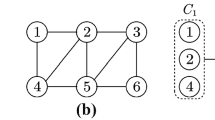Abstract
The Hamiltonian cycle problem (HCP) consists of finding a cycle of length N in an N-vertices graph. In this investigation, a graph G is considered with an associated set of matrices, in which each cell in the matrix corresponds to the weight of an arc. Thus, a multi-objective variant of the HCP is addressed and a Pareto set of solutions that minimizes the weights of the arcs for each objective is computed. To solve the HCP problem, the Branch-and-Fix algorithm is employed, a specific branching algorithm that uses the embedding of the problem in a particular stochastic process. To address the multi-objective HCP, the Branch-and-Fix algorithm is extended by computing different Hamiltonian cycles and fathoming the branches of the tree at earlier stages. The introduced anytime algorithm can produce a valid solution at any time of the execution, improving the quality of the Pareto Set as time increases.
Access this chapter
Tax calculation will be finalised at checkout
Purchases are for personal use only
Similar content being viewed by others
References
Ejov, V., Filar, J., Haythorpe, M., Nguyen, G.: Refined MDP-based branch-and-fix algorithm for the Hamiltonian cycle problem. Math. Oper. Res. 34, 758–768 (2009)
Feinberg, E.: Constrained discounted Markov decision process and Hamiltonian cycles. Math. Oper. Res. 25, 130–140 (2000)
Goldberg, D., Lingle, R.: Alleles, loci and the traveling salesman problem. In: Proceedings of the 1st International Conference on Genetic Algorithms and Their Applications, pp. 154–159 (1985)
Haythorpe, M.: Markov chain based algorithms for the hamiltonian cycle problem. PhD. Thesis, University of South Australia (2011)
Lenstra, J., Kan, A.R.: Some simple applications of the travelling salesman problem. J. Oper. Res. Soc. 26, 717–733 (1975)
Nguyen, G.: Hamiltonian cycle problem, Markov decision processes and graph spectra. Ph.D. Thesis, University of South Australia (2009)
Acknowledgements
This project was funded by the ELKARTEK Research Programme of the Basque Government (project KK-2019/00068). This work has been possible thanks to the support of the computing infrastructure of the i2BASQUE academic network. The work of Roberto Santana was funded by the Basque Government (project IT-1244-19), and Spanish Ministry of Economy and Competitiveness MINECO (project TIN2016-78365-R).
Author information
Authors and Affiliations
Corresponding author
Editor information
Editors and Affiliations
Rights and permissions
Copyright information
© 2020 The Editor(s) (if applicable) and The Author(s), under exclusive license to Springer Nature Switzerland AG
About this paper
Cite this paper
Murua, M., Galar, D., Santana, R. (2020). Adaptation of a Branching Algorithm to Solve the Multi-Objective Hamiltonian Cycle Problem. In: Neufeld, J.S., Buscher, U., Lasch, R., Möst, D., Schönberger, J. (eds) Operations Research Proceedings 2019. Operations Research Proceedings. Springer, Cham. https://doi.org/10.1007/978-3-030-48439-2_28
Download citation
DOI: https://doi.org/10.1007/978-3-030-48439-2_28
Published:
Publisher Name: Springer, Cham
Print ISBN: 978-3-030-48438-5
Online ISBN: 978-3-030-48439-2
eBook Packages: Business and ManagementBusiness and Management (R0)




